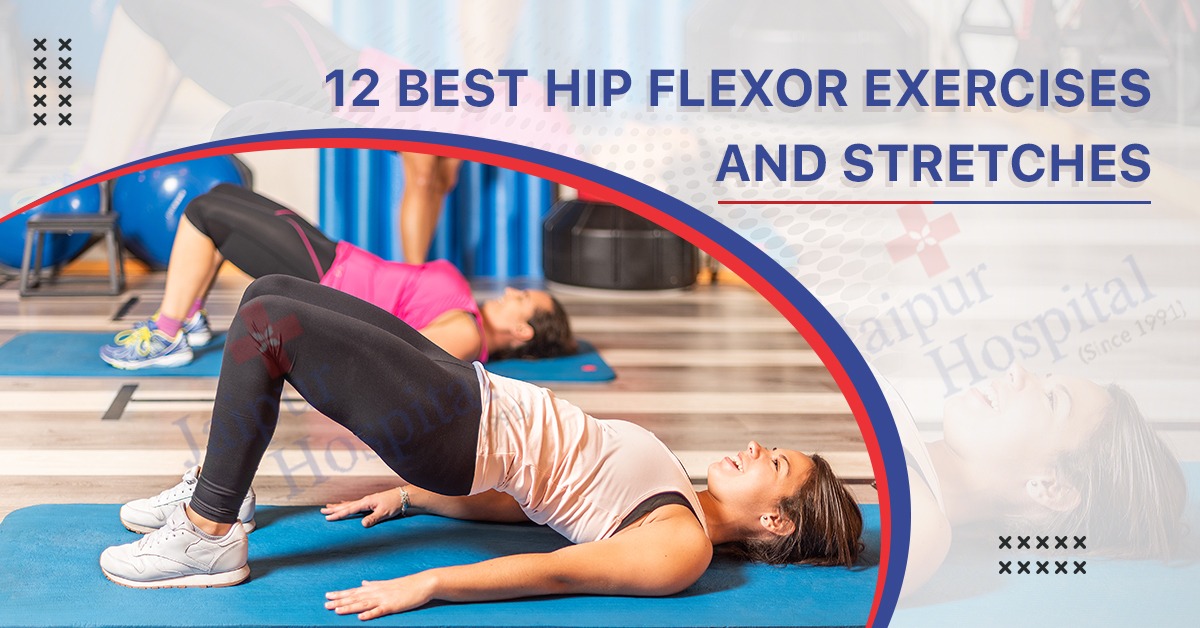Lower back pain, hip pain, and injury can all result from tight and weak hip flexors. Yoga poses and other hip flexor exercises can support muscle growth and tension relief.
Despite the fact that not everyone can have hips as flexible as Shakira’s, we can all gain from stretching and building up the muscles that support these ball-and-socket joints.
Hips play a role in more than just the occasionally-performed rocking dance moves. Due to their importance for mobility and movement, they are crucial for everyone, including non-athletes and bike riders.
Most of us spend the majority of the day sitting, which makes our hip flexors tight. Additionally, a sedentary lifestyle is linked to weak hip muscles, including the glutes, hamstrings, and abductors as well as the hip flexors and muscles that oppose them. Hip pain, lower back pain, and injury can all be brought on by tight and weak hip flexors.
What Are the Hip Flexors?
Several muscles along the front of your upper thigh make up your hip flexors. They comprise the iliacus, rectus femoris, psoas major, and sartorius.
The primary hip flexors are the iliacus and psoas major, which cooperate to bend and stabilize your hip and draw your thigh and torso together when you walk, run, sit, or stand. While the sartorius aids in flexing and externally rotating the hip and knee, the rectus femoris aids in hip flexion and knee extension.
Tight hip flexors make it more difficult for your pelvis to rotate properly, which can affect several other areas of your body because the hips connect the lower back to the legs. Hip pain or discomfort that typically worsens with extended sitting or repetitive hip-flexion exercises like running and cycling are indicators that your hip flexors are tight.
Benefits of Hip Flexor
Even if you don’t feel tight, it’s still important to take care of your hips, particularly if you’re under stress. The hips are the primary site of energy transfer between the upper and lower halves of the body, which is necessary for movement and function. You can release some tension and boost your energy by opening your hips.
Consistently stretching your hips may also have the following advantages:
● a reduction in hip flexor tightness
● less lower-back discomfort
● an improvement in hip range of motion
● Lower injury
● improved performance
You can also read:- What is Myofunctional Therapy: What It Treats, Exercise, and How It Works?
12 Best Hip Flexor Exercises and Stretches
To relax your hip flexors and joints, try performing these stretches. They are intended to broaden the range of motion the joint can experience. When your body is warmed up from exercise, these stretches are excellent to do.
1. Floor-sliding mountain climbers
Gather some sliding objects, such as paper plates, hand towels, or sliding discs.
● Place yourself on a smooth surface, such as a wood floor.
● While performing a pushup, place the sliders under the balls of your feet.
● As with standard mountain climbers, bring your left leg in first, then your right, alternately.
● Take it slow at first, then quicken your pace.
2. Side Plank With Knee Drive
It is more difficult for the bottom glute to isometrically support the body weight in that stable position because of the dynamic action of the moving leg.
● Starting in a side plank position, extend your legs, stack your hips, knees, and ankles, and place your left elbow under your shoulder. Ensure that your lower back is flat, that your core is engaged, and that your butt is tucked in.
● Drive your right knee up and toward your chest gradually. Take a brief pause before slowly extending the leg back to its starting position. It’s one rep.
● Do 5-8 repetitions on each leg.
3. Half-kneeling hip flexor stretch
This easy exercise will stretch the glutes in the front leg and the iliopsoas/hip flexors in the back leg. This exercise can be done on a yoga mat or with a folded towel placed under your knee.
● Kneel on the ground with your right knee in front of you and your left foot flat on the ground.
● Maintain a tall trunk throughout this exercise. To maintain balance, you can keep your hands on your left knee.
● You should feel a slight stretch in the front of your hip after gently sliding your right knee back.
● Bring your trunk and hips toward your left foot by tightening your right glute and acting as though you are pushing forward. Tuck your hips slightly, creating a pelvic tilt.
● Hold this position for 10–30 seconds while taking a deep breath.
4. Knee to chest stretch
This exercise helps to stretch the muscle of the body, which helps in hip flexor also.
● Lay on your back with your legs outstretched. Kneel slowly and bring it up to your chest.
● Pull your knee as close to your chest as you can without feeling any pain while maintaining a flat back.
● Stretch out your straight leg as far as you can while contracting your glute.
● Repeat with your other leg, then go back to the starting position.
● If you are having trouble feeling the stretch, try doing it while leaning against a bench with your lower leg hanging off.
5. Pigeon Pose
An advanced posture in yoga is called the pigeon. Do it only if you are at ease in the pose. You can change it by reclining or sitting in a chair and performing a figure-four stretch.
● Begin with a plank position.
● Your left knee should be on the ground next to your left hand, and your foot should be close to your right hand as you lift your left foot off the ground and slide it forward. The exact position of your knee and toes will depend on how flexible you are.
● Maintaining a square hip position, slide your right leg back as far as you can. Bring your upper body as low as you can, all the way to the floor and onto your elbows.
● Without letting your chest drop, hold the stretch. Change sides as soon as you feel you’ve had a good stretch.
You can also read:- Broken Tailbone: Causes, Symptoms, Treatment, and Recovery
6. Step Up to Reverse Lunge
It’s an excellent method for boosting exercise intensity without gaining weight.
● Face a chair, step, bench, or box as you stand there.
● Drive through your right heel and glute as you step onto the box with your right foot to raise your left leg to meet your right. Keep the majority of your weight on your right foot while allowing your left foot to hover.
● Step your left foot back down, step your right foot back about two feet, and then lower yourself into a reverse lunge right away.
● To complete one rep, push through your left foot to stand back up and proceed directly to the following step-up.
● Do 12 to 15 reps on each leg.
7. Explosive Sprinters Lunge
● Place your feet hip-width apart and stand tall.
● Put your right foot in a lunge position by moving it a few steps back.
● Driving your right knee toward your chest, drive through your left foot and leap into the air with explosive force.
● Step back into another lunge after a soft-knee landing (one repetition).
● Do 10 to 12 reps on each leg.
8. Bridge
The majority of hip movements are built on this posture. This exercise also referred to as the glute bridge, can be done dynamically or as an isometric hold.
● Kneel up toward the ceiling while bending your legs and lying on your back on the floor. Your arms should be extended straight out to either side of you, and your feet should be hip-distance apart.
● Put your shoulders and feet firmly on the ground while lifting your hips. To help you remain stable, use your hands.
● Lower your hips back to the ground.
● Do 12 to 15 reps.
9. Squats
All people should include squats in their lower body routine. They are effective at boosting the strength of the hip flexor complex and legs. They also aid in enhancing lower body mobility.
● Put your feet hip-width apart and maintain a straight posture as you stand.
● By pushing your hips back and bending at the knees and hips, you can lower them to the ground. The ground should be parallel to your thighs.
● Legs straightened, push yourself up, then revert to the starting position.
● Do 12 to 15 reps.
10. Straight leg raise
Leg raises are a good way to strengthen your hips and core. It might be successful to try it with just one leg. Here’s how they are done:
● On the floor, lie on your back.
● Put your hands behind your buttocks or lower back.
● Straighten out your legs in front of you so that they are at a 90-degree angle with the ground. Your toes should be pointed upward.
● Avoid letting them touch the ground as you lower the objects back down. Make sure that the ground is flat behind your lower back.
● Do 15 to 20 repetitions.
11. Mountain climbers
This well-known core exercise can also be used as a HIIT move. Here is how to do it:
● Step onto the floor and assume a high plank position.
● As you raise your right leg, point it in the direction of your right elbow.
● Returning the right leg straight, bring the left knee in a similar motion, pointing it toward the left elbow before extending it back.
● For ten to fifteen reps on each side, repeat this exercise while switching sides.
12. Psoas hold
This exercise lengthens strides and helps prevent injuries by strengthening the psoas, a deep hip flexor muscle.
● Bend your right knee while standing, then extend your upper right leg upward.
● For about 30 seconds, maintain balance on your left foot while keeping your right knee and thigh at hip level.
● Repeat with your left leg after slowly lowering your right one.
● Do not forget to maintain a tall trunk throughout the entire movement. Reduce the height of your leg lift if your head is bobbing forward or your chest is rounding.
● Do 15 to 20 repetitions.


